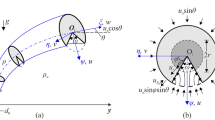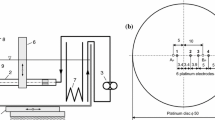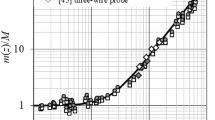Abstract
A simple modification is introduced into the integral model (IM) CorJet in an effort to predict better the characteristics of negatively buoyant jets (NBJ) discharged in a stationary ambient. Although this modification was developed for the CorJet model, it can be applied to every IM which employs the entrainment hypothesis. The detrainment of fluid from the main flow is taken into account by inserting a coefficient “p” into the conservation equations of volume, buoyancy and tracer mass flux. This coefficient expresses the ratio of the specific mass flux of the detrained fluid to the net specific mass flux entrained to the NBJ. The value of p is assumed constant along the jet trajectory and up to the maximum jet height, becoming zero thereafter. Results show that the modified CorJet model (MCM) predicts reasonably well experimental data from the literature and data from experiments performed in this work. The optimal value of p and therefore the detrained fluid from the main NBJ flow was found to decrease as the jet initial densimetric Froude number increases.









Similar content being viewed by others
References
Besalduch LA, Badas MG, Ferrari S, Querzoli G (2013) Experimental studies for the characterization of the mixing processes in negative buoyant jets. EPJ Web Conf 45(01012):1–9
Christodoulou GC, Papakonstantis IG (2010) Simplified estimates of trajectory of inclined negatively buoyant jets. In: Christodoulou GC, Stamou AI (eds) Environmental hydraulics, vol I. Taylor & Francis, London, pp 165–170
Cipollina A, Bonfiglio A, Micale G, Brucato A (2004) Dense jet modelling applied to the design of dense effluent diffusers. Desalination 167:459–468
Cipollina A, Brucato A, Grisafi F, Nicosia S (2005) Bench-scale investigation of inclined dense jets. J Hydraul Eng (ASCE) 131:1017–1022
Davidson MJ, Oliver CJ (2012) Desalination and the environment. In: Fernando HJ (ed) Handbook of environmental fluid mechanics, Vol 2: Systems, pollution, modeling and measurements. CRC Press, Taylor & Francis, Boca Raton, pp 41–54
Doneker RL, Jirka GH (2007) CORMIX user manual: a hydrodynamic mixing zone model and decision support system for pollutant discharges into surface waters. MixZon Inc, Portland
Ferrari S, Querzoli G (2010) Mixing and re-entrainment in a negatively buoyant jet. J Hydraul Res 48(5):632–640
Jirka GH (2004) Integral model for turbulent buoyant jets in unbounded stratified flows - Part I: single round jet. Environ Fluid Mech 4:1–56
Jirka GH (2008) Improved discharge configurations for brine effluents from desalination plants. J Hydraul Eng (ASCE) 134(1):116–120
Kikkert GA (2006) Buoyant jets with two and three dimensional trajectories. PhD thesis, University of Canterbury, Christchurch, New Zealand
Kikkert GA, Davidson MJ, Nokes RI (2007) Inclined negatively buoyant discharges. J Hydraul Eng (ASCE) 133:545–554
Lai CCK, Lee JHW (2012) Mixing of inclined dense jets in stationary ambient. J Hydro-Environ Res 6:9–28
Lee JHW, Chu VH (2003) Turbulent jets and plumes: a Lagrangian approach. Kluwer Academic Publishers, Dordrecht
Nemlioglu S, Roberts PJW (2006) Experiments on dense jets using 3D laser-induced fluorescence (3DLIF). In: 4th International conference on marine waste water disposal and marine environment
Oliver CJ (2012) Near field mixing of negatively buoyant jets. PhD thesis, University of Canterbury, Christchurch, New Zealand
Oliver CJ, Davidson MJ, Nokes RI (2013) Predicting the near-field mixing of desalination discharges in a stationary environment. Desalination 309:148–155
Palomar P, Lara JL, Losada IJ (2012) Near field brine discharge modeling part 2: validation of commercial tools. Desalination 290:28–42
Papakonstantis IG (2009) Turbulent round negatively buoyant jets at an angle in a calm homogeneous ambient. PhD thesis, School of Civil Engineering, National Technical University of Athens, Greece (in Greek)
Papakonstantis IG, Christodoulou GC, Papanicolaou PN (2011) Inclined negatively buoyant jets 1: geometrical characteristics. J Hydraul Res 49(1):3–12
Papakonstantis IG, Christodoulou GC, Papanicolaou PN (2011) Inclined negatively buoyant jets 2: concentration measurements. J Hydraul Res 49(1):13–22
Papanicolaou PN, Papakostantis IG, Christodoulou GC (2008) On the entrainment coefficient in negatively buoyant jets. J Fluid Mech 614:447–470
Roberts PGW, Ferrier A, Daviero G (1997) Mixing in inclined dense jets. J Hydraul Eng (ASCE) 123:693–699
Roberts PGW, Toms G (1987) Inclined dense jets in flowing current. J Hydraul Eng (ASCE) 113:323–341
Shao D, Law AWK (2010) Mixing and boundary interactions of \(30^{\circ }\) and \(45^{\circ }\) inclined dense jet. Environ Fluid Mech 10:521–553
Stamou AI, Nikiforakis IK (2013) Integrated modelling of single port, steady-state thermal discharges in unstratified coastal waters. Environ Fluid Mech 13(4):309–336
Yannopoulos PC, Bloutsos AA (2012) Escaping mass approach for inclined plane and round buoyant jets. J Fluid Mech 695:81–111
Zeitoun MA, McIlhenny WF, Reid RO (1970) Conceptual designs of outfall systems for desalting plants. Tech Rep R&D Progress Report, 550, Office of Saline Water, US Dept of Interior
Acknowledgments
This research has been co-financed by the European Union (European Social Fund – ESF) and Greek national funds through the Operational Program “Education and Lifelong Learning” of the National Strategic Reference Framework (NSRF) - Research Funding Program: Heracleitus II. Investing in knowledge society through the European Social Fund.
Author information
Authors and Affiliations
Corresponding author
Appendices
Appendix 1: Entrainment coefficient in the IM CorJet
CorJet is based on the entrainment hypothesis for the closure of conservation equations. According to this hypothesis, the entrainment velocity \(\hbox {u}_{\mathrm{e}^{*}}\) at the nominal jet width \(\hbox {b}_{*}\) is equal to the local jet centerline velocity \(\hbox {u}_{\mathrm{c}^*}\) multiplied by the entrainment coefficient \(\upalpha \), i.e. \(\hbox {u}_{\mathrm{e}^{*}}=\upalpha \hbox {u}_{\mathrm{c}^{*}}\) [12].
In CorJet, the entrainment coefficient \(\upalpha \) is assumed to be variable taking the asymptotic values \(\upalpha _\mathrm{j}\) and \(\upalpha _\mathrm{p}\) in the regions where the flow is momentum (jet-like) and buoyancy (plume-like) dominated, respectively, and the values in between at the transition from jets to plumes. Equation 23 gives the expression of \(\upalpha \),
where \(\upalpha _\mathrm{j}=0.055,\,\upalpha _\mathrm{p}=0.083\) and \(\hbox {F}_\mathrm{l}\) and \(\hbox {F}_\mathrm{lp}\) are the local densimetric Froude number and the densimetric Froude number for the pure plume, respectively. \(\hbox {F}_\mathrm{l}\) and \(\hbox {F}_\mathrm{lp}\) are given by Eqs. 24 and 25, where \(\hbox {g}_\mathrm{c}\)’ is the apparent gravitational acceleration on the jet axis given by Eq. 26.
As observed in Eq. 23, the second term on the R.H.S. is negative as long as the term \(\hbox {F}_{\mathrm{l}}^{2}/\hbox {sin}\uptheta \) is negative. Since \(\hbox {F}_{\mathrm{l}}^{2}\) is always less than zero for NBJ \((\uprho _\mathrm{a}<\uprho _\mathrm{o})\), the sinus of the local jet inclination \((\uptheta )\) determines the sign of \(\hbox {F}_{l}^{2}/\hbox {sin}\uptheta \). This means that the entrainment coefficient \(\upalpha \) takes values less than \(\upalpha _\mathrm{j}\) along the ascending flow region of NBJ and greater than \(\upalpha _\mathrm{j}\) at the descending flow region. At the maximum jet rise height, \(\hbox {sin}\uptheta \) becomes equal to zero and therefore \(\upalpha =\upalpha _\mathrm{j}\). It is noted that as the plume is the final stage of flow for buoyant jets, the maximum value that \(\upalpha \) can take is \(\upalpha _\mathrm{p}\). \(\upalpha \) is also affected by \(\uptheta \). As \(\uptheta \) takes greater values, as is the case for large discharge angles, \(\upalpha \) takes smaller values in the ascending flow region of NBJ.
The complete behavior of \(\upalpha \) implemented in CorJet for NBJ discharged into stagnant ambient, is shown in Fig. 10. It is seen that in the ascending region of flow, the reduction of \(\upalpha \) is described by Eq. 23. The minimum value that \(\upalpha \) takes is \(\upalpha =\upalpha _\mathrm{j}\)-(\(\upalpha _\mathrm{p}-\upalpha _\mathrm{j})\cdot \hbox {sin}\uptheta \), which is dependent only on \(\uptheta \) and therefore on \({\uptheta }_\mathrm{o}\). Beyond this point, \(\upalpha \) is assumed to increase linearly between the ascending and descending regions of flow, reaching, eventually, the value \(\upalpha _\mathrm{p}\). It is noted that Jirka [8] assumed this linearity in CorJet due to lack of precise experimental data along the jet path.
Behavior of the entrainment coefficient \(\upalpha \) for NBJ discharged into a stationary ambient (as adapted from [8])
Appendix 2: Expressions for local jet parameters in the ZEF
Appendix 3: Expressions for jet parameters at the end of ZOFE
where \(\hbox {L}_{\mathrm{e}^{*}}\) is the dimensionless modified ZOFE length.
Rights and permissions
About this article
Cite this article
Nikiforakis, I.K., Stamou, A.I. & Christodoulou, G.C. A modified integral model for negatively buoyant jets in a stationary ambient. Environ Fluid Mech 15, 939–957 (2015). https://doi.org/10.1007/s10652-014-9388-6
Received:
Accepted:
Published:
Issue Date:
DOI: https://doi.org/10.1007/s10652-014-9388-6





